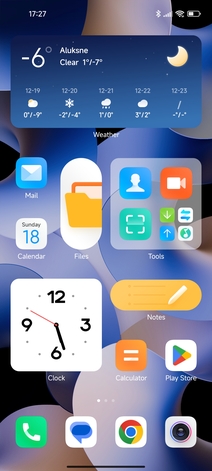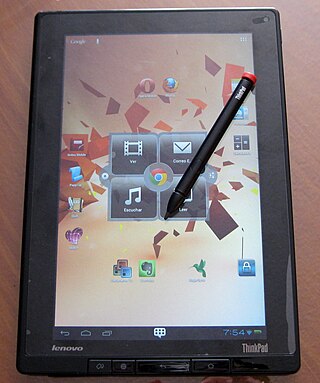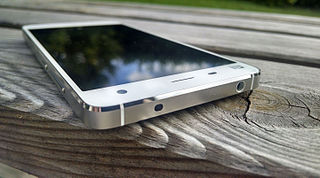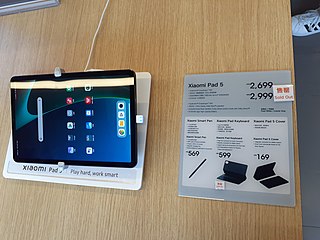
A tablet computer, commonly shortened to tablet, is a mobile device, typically with a mobile operating system and touchscreen display processing circuitry, and a rechargeable battery in a single, thin and flat package. Tablets, being computers, have similar capabilities, but lack some input/output (I/O) abilities that others have. Modern tablets largely resemble modern smartphones, the only differences being that tablets are relatively larger than smartphones, with screens 7 inches (18 cm) or larger, measured diagonally, and may not support access to a cellular network. Unlike laptops, tablets usually run mobile operating systems, alongside smartphones.
A mobile operating system is an operating system for smartphones, tablets, smartwatches, smartglasses, or other non-laptop personal mobile computing devices. While computers such as typical/mobile laptops are "mobile", the operating systems used on them are generally not considered mobile ones, as they were originally designed for desktop computers that historically did not have or need specific mobile features. This line distinguishing mobile and other forms has become blurred in recent years, due to the fact that newer devices have become smaller and more mobile unlike hardware of the past. Key notabilities blurring this line are the introduction of tablet computers and light-weight laptops and the hybridization of the two in 2-in-1 PCs.

The Asus Eee Pad Transformer TF101 is a 2-in-1 detachable tablet developed by Asus that runs the Android operating system. It is the first tablet in the Asus Transformer Pad series. The Eee Pad Transformer features a 10.1-inch (260 mm) display, an Nvidia Tegra 2 dual-core chip, 1 GB of RAM, and 16 or 32 GB of storage. The tablet initially launched with Android 3.1, nicknamed "Honeycomb", but was updated to support Android 4.0.3.

MIUI is a mobile operating system developed and maintained by manufacturer Xiaomi exclusively for its smartphones and related communication devices. MIUI is based on the Android Open Source Project (AOSP) version of Android, and serves as the basis for other operating systems created by Xiaomi: MIUI for POCO, MIUI Pad, MIUI Watch, MIUI TV (PatchWall), Redmi and Redmi Note.

The ThinkPad Tablet is a tablet computer made by Lenovo as part of its series of Android-based tablet devices and is targeted towards business users. Lenovo's tablet offerings are available in both ThinkPad and IdeaPad variants. While the ThinkPad Tablets are designed for business, the IdeaPad tablets, like the laptops of the same name, are meant for home and personal use. These tablets are different from Lenovo's X Series tablets, which are laptop/tablet hybrids and which use Microsoft Windows as their operating system.
The IdeaPad tablets from Lenovo were a brand of consumer-oriented tablet computers designed for home use or entertainment, as opposed to the business-focused ThinkPad Tablet series. Devices sold in certain countries, such as China, India and New Zealand, were sold under the LePad brand, similar to the LePhone series of smartphones. IdeaPad-branded tablets have been produced with the Android and Windows operating systems.
Atom is a system on a chip (SoC) platform designed for smartphones and tablet computers, launched by Intel in 2012. It is a continuation of the partnership announced by Intel and Google on September 13, 2011 to provide support for the Android operating system on Intel x86 processors. This range competes with existing SoCs developed for the smartphone and tablet market from companies such as Texas Instruments, Nvidia, Qualcomm and Samsung. Unlike these companies, which use ARM-based CPUs designed from the beginning to consume very low power, Intel has adapted the x86-based Intel Atom line of CPU developed for low power usage in netbooks, to even lower power usage.
Xiaomi Mi 2, is an Android smartphone produced by Xiaomi Tech. The device features a quad-core 1.5 GHz Qualcomm Snapdragon S4 Pro as its CPU. The device initially sold for ¥1999 in China.

The ThinkPad Tablet 2 is a tablet computer announced in 2012 and released by Lenovo in 2013.

The Xiaomi Mi 4 is a smartphone developed by the Chinese electronics manufacturer Xiaomi for its high-end smartphone line, and was released in August 2014. Xiaomi held an event to formally introduce the high-end phone, and its complementary smart-accessory, the Xiaomi MiBand, during the Xiaomi New Product Launch Event 2014 on 22 July 2014.

The Xiaomi Redmi Note 3 is a smartphone developed by Xiaomi Inc. as part of Xiaomi's low-end Redmi smartphone line. It has three variants:

The Xiaomi Mi Pad is a tablet computer produced by Xiaomi. It is Xiaomi's first tablet and is manufactured by Foxconn. The device is available in two storage sizes, 16 GB and 64 GB.

The Xiaomi Mi Smart Band 6 is a wearable activity tracker produced by Xiaomi Inc. It was announced in China on 29 March 2021, and was available starting 2 April 2021 in China. It has a 1.56-inch, 152 x 486 pixels resolution capacitive AMOLED display and 24/7 heart rate monitor and a SpO2 sensor. It also comes with a NFC variant. Mi Smart Band 6 allows for the unlocking of Windows laptops through Windows Hello.

Xiaomi Pad 5 is a line of Android-based tablet computers manufactured by Xiaomi. It was announced on August 10, 2021 with Xiaomi MIX 4.
Redmi Pad is an Android tablet computer designed, marketed and manufactured by Xiaomi. This tablet computer was announced on October 4, 2022, it was released on October 5, 2022.

The Xiaomi Mi Pad 3 is a tablet released in 2017 April shipped with Android 7 with MIUI 9. It remains similar to design to its two predecessors Xiaomi Mi Pad 2 and Xiaomi Mi Pad. It is succeeded by Xiaomi Mi Pad 4
The Xiaomi Mi Pad 4 and Xiaomi Mi Pad 4 Plus is two budget tablets made by Xiaomi. It's successor, the upper mid range Xiaomi Pad 5, are not released till 2021. The Xiaomi Mi Pad 4 Plus is the larger tablet at 10.1 inches screen, while the Mi Pad 4 is 8.0 inches. Both tablets have the Qualcomm Snapdragon 660 chipset.
The Xiaomi Mi Pad 6 is a line of mid-range to high end tablets manufactured by Xiaomi.










